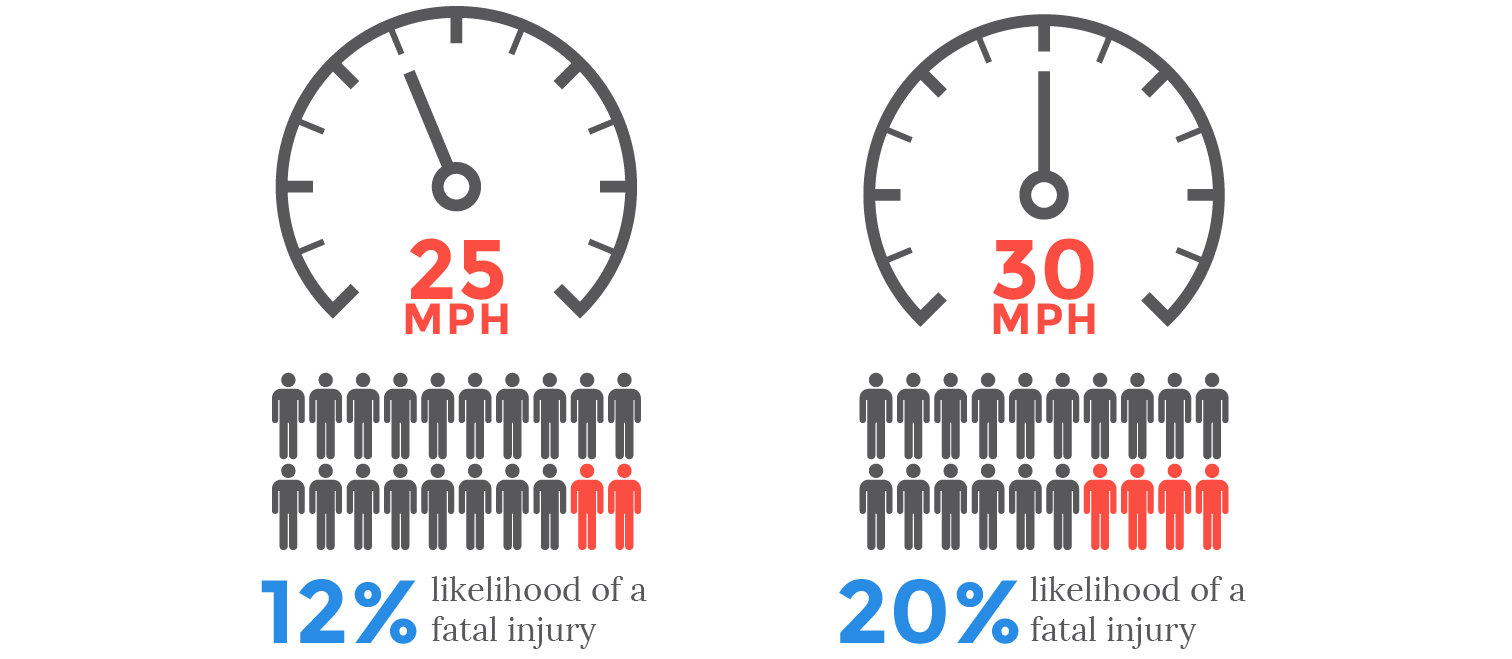Boston pursuing 25 mph speed limit
Pending approval from the City Council, the new default speed limit is expected to take effect on January 1, 2017.
Boston Mayor Martin J. Walsh and City of Boston Transportation Commissioner Gina N. Fiandaca will be working with the Boston City Council to pursue lowering the default speed limit in the City of Boston from 30 mph to 25 mph.
Reducing the default speed limit from 30 mph to 25 mph will help to make the city safer for people of all ages and abilities who are walking, driving, and bicycling on our streets. The new, lower speed limit would be a major early accomplishment for our Vision Zero goal: bringing the number of traffic deaths and serious injuries to zero by 2030. Data show when you’re driving at or below 25 mph, you are more able to avoid crashes.
Pedestrians struck by drivers traveling at 25 mph are half as likely to die as those struck by drivers traveling at 30 mph.
Boston’s 25 mph default speed limit would be on par with other U.S. cities, such as New York City, Los Angeles, and Washington, D.C., that have made it a priority to reduce fatalities and serious injuries on their streets. Many major cities around the world, including London, Paris, Berlin, and Tokyo, have a speed limit set at 25 mph or lower and have fewer traffic deaths.
Reducing the speed limit won’t have an impact on your ability to move efficiently throughout Boston. Vehicle speed is primarily determined by factors like traffic congestion, double-parked vehicles, turning vehicles, and traffic signals. A lower speed limit will not impact speeds during the most congested times of day, when many drivers already travel at speeds below 25 mph.
Why we’re planning to make the change
Reaching our goal of zero traffic fatalities and serious injuries will require everyone – drivers, bicyclists, and pedestrians alike – to join together to be part of the solution. Legislative efforts, like lowering the speed limit, combined with enhanced street design, education and enforcement policies work together to create a street system and standard of behavior that dramatically lessens the consequences of everyday mistakes. Mistakes can and will happen, but they should not be deadly or lead to serious, life-altering injury.
When drivers are going 25 mph, drivers and pedestrians have more time to see each other and react. This small 5 mph decrease in speed means that many crashes can be avoided altogether, and, if a crash happens, it’s less likely to cause serious injury or death. If a crash does happen, research shows that pedestrians struck by drivers going 25 mph are half as likely to be killed as those struck by drivers at 30 mph. (Tefft, 2011)
This new law is one aspect of Mayor Walsh’s comprehensive Vision Zero Action Plan to end traffic deaths and serious injuries. The plan sets out a robust platform of additional legislation, street design, and education to reduce traffic fatalities in Boston. You can learn more about Vision Zero by visiting visionzeroboston.org.
Updating street signs and educating people in Boston
With City Council’s approval, as of January 1, 2017, the 25 mph default citywide speed limit will affect all streets where there is no posted speed limit.
If you don’t see a posted sign, the speed limit is 25 mph.
Before and after the law goes into effect, we’ll work to inform people of the new default speed limit through a widespread public outreach campaign. Additionally, old 30 mph signs will be replaced, and new signs will be posted telling people about the 25 mph speed limit at important entry points into the City.
We will continue to sign some smaller streets for speeds less than 25 mph. This includes safety zones and areas where there are traffic calming measures in place.
We will also continue to sign some larger streets, such as limited access highways or major arterial streets, at or above 30 mph. Since these kinds of roads are meant to serve people traveling at higher speeds, we will study these locations before dropping the speed limit.
Fines for speeding
Compliance will be our main measure for success, and we hope that everyone will choose to drive at safe speeds. However, the Boston Police Department is committed to achieving Vision Zero and will use enforcement to deter violations of the speed limit.
Please keep in mind that the penalty for violating the speed limit will not change. The fine for exceeding the speed limit in Massachusetts is $105. If you drive more than 10 mph over the speed limit, you have to also pay $10 for each mile per hour that you are over.
Drivers may get more penalties, but it depends on the severity of the ticket and the person’s driving history. Drivers also get points on their license for speeding.
If you have questions about the proposed speed limit change please e-mail visionzero@boston.gov.
---
Thanks to the New York Department of Transportation for sharing the basis for this document.
Sources: Tefft, Brian C. Impact Speed and a Pedestrian’s Risk of Severe Injury or Death, AAA Foundation for Traffic Safety, Washington DC, September, 2011


